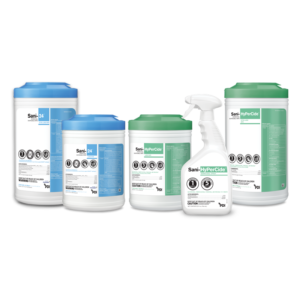Interventional Care


We notice that you are visiting us from . This site only services US-based visitors. Would you like to visit the site that is appropriate for your location?

A layered approach to infection prevention is essential amid the ongoing pandemic and rising healthcare-associated infections (HAIs)
PDI, a global leader in infection prevention products and solutions, announced today the dual launch of novel, innovative disinfectants to help infection prevention professionals in the fight against rising healthcare-associated infections (HAIs) as well as the ongoing battle against COVID-19. As part of a layered approach, the new products, Sani-24® Germicidal Disposable Wipe, Sani-HyPerCide® Germicidal Disposable Wipe and Sani-HyPerCide® Germicidal Spray further support PDI’s commitment to help prevent infections and promote health and wellness.
Sani-24 wipe is the first and only EPA registered disinfectant that uses continuously active disinfectant (CAD), a revolutionary technology developed by a leader in antimicrobial solutions, Microban.® CAD provides protection against a wide array of pathogenic organisms within a one-minute contact time, while leaving a protective layer of disinfectant on the surface as it dries. This anti-microbial shield will continuously kill ESKAPE pathogens,1 which are responsible for over 40 percent of HAIs in the healthcare environment,2 as well as SARS-CoV-2, the virus that causes COVID-19.
“With constant challenges to control and prevent infections in healthcare settings, Sani-24 wipe is an important addition to our innovative portfolio of disinfectants that help maintain a clean and safe environment,” said Jake Watts, Vice President, Upstream Marketing, PDI. “Given PDI’s long legacy of pioneering important infection prevention solutions, we are proud to offer healthcare facilities a solution that protects surfaces and equipment from recontamination around the clock.”
Sani-HyPerCide disinfectant, available in wipe and spray formats, is a new, powerful and ready-to-use cleaner with a non-bleach, hydrogen peroxide formula effective against more than 20 HAI-causing microorganisms,3 including the highly-contagious, difficult-to-eradicate pathogens, Clostridioides difficile (C. diff4), Candida auris (C. auris), and norovirus, as well as SARS-CoV-2. Designed as an alternative to bleach disinfectants, the Sani-HyPerCide portfolio provides easy-to-use and efficient one-step cleaning and disinfecting used for daily, terminal and outbreak cleaning, compatible with most materials and surfaces, and requires no mixing or diluting.5 Its innovative formulation and multi-purpose usability enhances overall time efficiency and reduces risk of uniform discoloration as seen with bleach products.6
Recently, hospital and healthcare settings have experienced an alarming rise in serious and emerging pathogens. In fact, a report by the Centers for Disease Control and Prevention (CDC) showed that, after years of decline, U.S. hospitals saw significant increases in HAIs in 2020, largely as a result of the COVID-19 pandemic. The CDC has also deemed superbugs such as C. diff and C. auris as urgent threats to the U.S healthcare system due to their extremely contagious nature, high mortality rate and resistance to treatment.
“Today’s vulnerable healthcare environment has prompted an urgent need to strengthen infection prevention programs to better safeguard patients and staff,” said Watts. “Multiple layers of defense, including effective and easy-to-use disinfectants, will continue to be key to helping prevent infections, save costs, and improve care.”
About PDI
PDI is dedicated to leading the fight against preventable infections in healthcare, foodservice and our communities. Driven by a commitment to research, quality and service, PDI provides innovative products, educational resources, training and support to help prevent infection transmission and promote health and wellness. PDI has three divisions, PDI Healthcare, Sani Professional and PDI Contract Manufacturing. For more information visit: WeArePDI.com.
1 ESKAPE pathogens: Acinetobacter baumannii MDR, Enterobacter aerogenes, Enterobacter aerogenes MDR, Enterococcus faecalis VRE (Vancomycin resistant enterococcus), New Delhi Metallo-beta-lactamase-1 (NDM-1) producing Klebsiella pneumoniae (CRE – Carbapenem resistant Enterobacteriaceae), Pseudomonas aeruginosa, Staphylococcus aureus, Staphylococcus aureus MRSA (Methicillin Resistant).
2 ESKAPE pathogens are responsible for 40% of Healthcare-Associated Infections (HAIs); Magill, et.al. Multistate Point-Prevalence Survey of Health Care–Associated Infections, N Engl J Med 2014;370:1198-208; Boucher, et.al. Bad Bugs, No Drugs: No ESKAPE! An Update from the Infectious Diseases Society of America, Clinical Infectious Diseases 2009; 48:1–12Magill, et.al. Multistate Point-Prevalence Survey of Health Care–Associated Infections, N Engl J Med 2014;370:1198-208; b Boucher, et.al. Bad Bugs, No Drugs: No ESKAPE! An Update from the Infectious Diseases Society of America, Clinical Infectious Diseases 2009; 48:1–1
3 Contact time 1 minute for 24 microorganisms for the Sani-HyPerCide® wipe. Contact time 1 minute for 25 microorganisms for Sani-HyPerCide® spray. Both the wipe and spray formats have a 5-minute contact time for Clostridioides difficile (C.diff).
4 Clostridioides difficile spores formerly known as Clostridium difficile spores.
5 Refer to product manufacturer’s instructions for use.
6 Data on file at PDI, Inc.